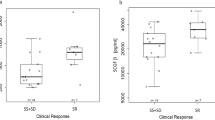Abstract
Tumor necrosis factor-α (TNF-α) levels in supernatant fluid from cultured peripheral blood mononuclear cells (PBMC) were measured by ELISA in 54 children with active non-inherited forms of primary nephrotic syndrome (PNS), 10 nephrotics in remission, and 10 healthy controls. Children with active PNS included 21 patients with steroid-sensitive (SS) minimal change nephrotic syndrome (MCNS), 5 patients with steroid–resistant (SR) MCNS, 11 with SR focal segmental glomerulosclerosis (FSGS), 6 patients with SS diffuse mesangial proliferation (DMP), 5 patients with SR DMP, and 6 patients with mesangiocapillary glomerulonephritis (MCGN). Patients with active PNS had elevated TNF-α production compared with controls. Remission was associated with normalization of TNF-α production. There was a positive correlation between TNF-α production and the degree of proteinuria (r=0.34, P=0.013), mesangial hypercellularity (r=0.42, P=0.028), and glomerulosclerosis (r=0.46, P=0.001). By using ROC curve, TNF-α production greater or equal to a cut-off point of 50 pg/ml could be used to predict resistance to steroid therapy (predictability 93.2%). By discriminate analysis, TNF-α production could be used to discriminate between patients with SR MCNS, SR FSGS, and SR DMP (predictability 100%). In conclusion, TNF-α from cultured PBMC might be involved in the pathogenesis of proteinuria as well as the pathological changes that occur in non-inherited forms of PNS. TNF-α levels in PBMC culture could be used to predict the pathological type of PNS and the response of these patients to steroid therapy.



Similar content being viewed by others
References
Shalhoub RJ (1974) Pathogenesis of lipid nephrosis a disorder of T cell function. Lancet II:556–560
Boulton-Jones JM, Tullock J, Dore B, McCay A (1983) Changes in glomerular capillary wall induced by lymphocyte products and serum of nephrotoxic patients. Clin Nephrol 20:72–77
Zimmerman SW (1984) Increased urinary protein excretion in the rat produced by serum from a patient with recurrent focal glomerular sclerosis after renal transplantation. Clin Nephrol 22:32–38
Schnaper HW, Pierce CW, Aune TM (1984) Identification and initial characterization of concanavalin A and interferon induced human suppressor factors: evidence of a human equivalent of murine soluble immune response suppressor (SIRS). J Immunol 132:2429–2435
Baud L, Fougueray B, Phillipe C (1992) TNF-α and mesangial cells. Kidney Int 41:600–603
Helle M, Boeije L, Aarden LA (1988) Functional discrimination between interleukin-6 and interleukin-1. Eur J Immunol 18:1535–1540
Jacobson SH, Lu Y, Brauner A (1996) Tumour necrosis factor soluble receptors I and II and interleukin-1 receptor antagonist in acute pyelonephritis in relation to bacterial virulence-associated traits and renal function. Nephrol Dial Transplant 11:2209–2214
Tullus K, Escobar-Billing R, Fituri O, Lu Y, Brauner A (1997) Soluble receptors to tumor necrosis factor and interleukin-6 in urine during acute pyelonephritis. Acta Paediatr 86:1198–1202
Takemura T, Yoshioka K, Murakami K (1994) Cellular localization of inflammatory cytokines in human glomerulonephritis. Vichows Arch 424: 459–464
Lee EY, Yang DH, Hwang KY, Hong SY (2001) Is tumor necrosis factor genotype (TNF A2/TNF A2) a genetic prognostic factor of an unfavorable outcome in IgA nephropathy? J Korean Med Sci 16:751–755
Suranyi MG, Guasch A, Hall BM, Myers BD (1993) Elevated levels of tumor necrosis factor alpha in nephrotic syndrome in human. Am J Kidney Dis 21:251–259
Bustos C, González E, Ross M, Muley R, Alonso JL, Egido J (1994) Increased TNF-α synthesis in peripheral blood mononuclear cells of children with idiopathic nephrotic syndrome. Eur J Clin Invest 24:799–805
International Study of Kidney Disease in Children (1981) The primary NS in children, identification of patients with minimal change NS for initial response to prednisone. J Pediatr 98:561–564
Boyiim A (1976) Isolation of lymphocytes, granulocytes and macrophages. Scand J Immunol [Suppl] 5:9–15
Amerdin A, Katz DH (1974) Activation of T and B-lymphocytes in vitro. II. Biological and chemical properties of an allogenic factor active in triggering specific B-lymphocytes. J Exp Med 140:1717–1722
Baud L, Ardaillou R (1995) TNF-α in renal injury. Miner Electrolyte Metab 21:336–341
Lama G, Luongo I, Tirino G, Borriello A, Carangio C, Salsano ME (2002) T-lymphocyte populations and cytokines in childhood nephrotic syndrome. Am J Kidney Dis 5:958–965
Niemir ZI, Ondracek M, Dworacki G (1998) In situ upregulation of TNF-α reflect the activity of human GN. Am J Kidney Dis 32:80–92
Nakamura T, Ebinhara I, Fukui S (1993) Altered glomerular steady state levels of TNF-α mRNA during nephrotic and sclerotic phases of puromycin aminonucleoside nephrosis in rats. Clin Sci (Colch) 84:349–356
Kocprzyk F (1999) TNF-α and IL-6 in patients with GN. Pol Arch Med Wewn 96:224–233
Ortiz A, Gomez-Chiarri M, Quiros J, Lobez-Armada MJ, Alonso J, Gonzales E, Egido J (1992) Exogenous fibronectin modifies tumour necrosis factor and fibronectin gene expression and catabolism of immune complexes in proliferative glomerulonephritis (Abstract). Nephrol Dial Transplant 7:676
Tanaka R, Yoshika N, Nakamura H (1992) Infusion of peripheral blood mononuclear cells products from nephrotic children increases albuminuria in rats. Nephron 60:35–41
Mahmud N, O'Connell MA, Slinson J (1995) TNF-α and microalbuminuria in patients with inflammatory bowel disease. Eur J Gastroenterol Hepatol 7:215–219
Inaba S, Takahashi T, Ishihara S, Kurose K, Arai M, Sakai Y, Yamamoto S (1996) Serum tumor necrosis factor in mesangial IgA glomerulonephritis with macroscopic hematuria in children. Nephron 72:518–522
Silver BJ, Jaffer FE, Abboud HE (1989) Platelet derived growth factor synthesis in mesangial cells: induction by multiple peptide mitogens. Proc Natl Acad Sci USA 86:1056–1060
Strutz F, Neilson EG (1994) The role of lymphocyte in the progression of interstitial disease. Kidney Int [Suppl] 45:S106–S110
Acknowledgement
This article was presented as a poster at the 12th congress of IPNA, 1–5 September 2001, Seattle, USA.
Author information
Authors and Affiliations
Corresponding author
Rights and permissions
About this article
Cite this article
Bakr, A., Shokeir, M., El-Chenawi, F. et al. Tumor necrosis factor-α production from mononuclear cells in nephrotic syndrome. Pediatr Nephrol 18, 516–520 (2003). https://doi.org/10.1007/s00467-003-1122-4
Received:
Revised:
Accepted:
Published:
Issue Date:
DOI: https://doi.org/10.1007/s00467-003-1122-4




